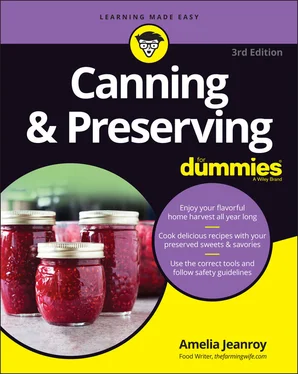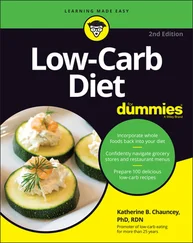Essential tools and utensils
If you’re serious about any work in the kitchen, these basic tools are indispensable. Purchase the best quality you can afford. Good-quality items will grow old with you.
Knives: You need three basic knives: a paring knife, a multipurpose knife with a 6-inch blade, and an 8-inch (some people prefer a 10-inch) chef’s knife. When purchasing quality knives, look for two options: stamped or forged blades and blades made of stainless or high-carbon steel (tempered steel knives are no longer the epitome of high-quality cutlery). Ceramic is another high-quality knife, but these high-priced knives are easier to damage than their steel counterparts. Also, if you select knives that are balanced, they will do the work for you. Properly caring for your knives protects your investment. Keep your knives razor-sharp. Store them in a block or a magnetic knife storage strip so they don’t touch each other. Hand-wash them (dishwashers are notorious for being hard on dishes, and knives take the brunt of banging around with the other silverware).
Measuring cups: Accuracy in measuring ingredients is essential to achieve the correct balance of ingredients for canning. There are two types of measuring cups: those for measuring dry ingredients, like flour, sugar, and solid fats, and those for measuring liquid ingredients (see Figure 2-1).Liquid measuring cups are made from glass, plastic, or metal. With glass measuring cups, you can easily see the amount of liquid in the cup. FIGURE 2-1:Measuring cups for dry and liquid food products.
Measuring spoons (see Figure 2-2): These come in graduated sizes from ⅛ teaspoon to 2 tablespoons. Note: Don’t use adjustable measuring spoons for canning foods; they move too easily and could give the wrong measurement. FIGURE 2-2:Some essential tools for canning. To avoid having to stop and clean your measuring spoons whenever you measure the same amount of wet and dry ingredients, have two sets handy, one for dry ingredients and the other for wet ingredients.
Spoons: You need at least a couple of cooking spoons made of nonreactive metal (like stainless steel) that won’t change the taste of acidic foods they come in contact with. Some choices for nonreactive metals are stainless steel, anodized aluminum, glass, or enameled cast iron. You can also use an assortment of different-sized wooden spoons and spatulas (see Figure 2-2).
Rubber spatulas (refer to Figure 2-2): These are available in a variety of colors and sizes, from flat to spoon-shaped. Use heat-resistant spatulas for cooking items containing sugar. Check that the end does not easily come off the handle, a common problem with less-expensive spatulas.
Tongs: Tongs are handy for all types of kitchen chores, especially moving large pieces of food into and out of hot water. Try the spring-loaded variety in different lengths. Don’t overlook a locking mechanism; it keeps the tongs closed when you’re not using them.
Ladle: Use a ladle that’s heatproof with a good pouring spout.
Potholders: Protect your hands from hot items. Have twice the number of potholders available than you think you’ll need. Potholders often get wet during canning. Have enough on hand so that you don’t have to use wet potholders. Heat quickly transfers through a wet potholder (in the form of steam), causing a severe burn. If you can find them, silicone potholders work exceptionally well, even against steam.
Kitchen towels and paper towels: Use these for cleaning your jar rims and as pads for your cooling jars.
Graters: A box grater (refer to Figure 2-2) gives you four or more options for shredding and grating. A microplane grater (see Figure 2-3) is an updated version of a rasp (a woodworking tool) that’s perfect for removing the zest from citrus fruit.
Zester (see Figure 2-3): Before the microplane grater, a zester was the tool for removing citrus fruit zest (just the skin without the bitter white part). It’s still an asset when you need a small amount of zest (a teaspoon or less), but for larger amounts, use a microplane grater. FIGURE 2-3:Microplane grater and zester.
Scissors: Use scissors instead of knives to open food packages. Avoid cross-contaminating bacteria by washing your scissors after opening meat packaging.
Timer (refer to Figure 2-2): Choose a timer that’s easy to read, easy to set, and loud enough to hear if you leave the room. Consider getting two to ensure accuracy. Your smartphone has an easy-to-read (and loud) timer!
Waterproof pens and markers: You can use these to label freezer items, and filled jars of canned or dried foods. Label everything as soon as it is ready. Don’t rely on your memory. Select pens and markers that don’t rub off.
Labels: You can make labels from masking or freezer tape, customize your own on your home computer, or order small quantities from online companies. Sometimes office supply stores have a nice selection of labels.
Cutting board: A good cutting board protects your knives while providing you with a movable work surface. Wooden cutting boards are my (Amy) material of choice. They are easier on your knives, are self-healing, and withstand a good cleaning. Plastic cutting boards are lighter in weight and less expensive, but they are hard on knives, and the gouges made by knives remain, providing a place for bacteria to hide. Their light weight can also make a plastic board less stable as it can easily move around on your prep surface. You can counter this by placing a kitchen towel down before using a plastic cutting board.
Candy thermometer: A candy thermometer accurately registers the temperature of candy and sugar. In canning, it’s used to check the temperature of cooked items. Some candy thermometers have marks indicating the gel point for jelly (220 degrees). Purchase a candy thermometer that’s easy to read, with a base to support the thermometer so the bulb portion doesn’t touch the bottom of your pan. If this occurs, your temperature reading won’t be accurate. Many come with a clip attached to keep the bulb off of the bottom. If you can, store a second thermometer in a handy location. If you accidentally break one while canning, you will have a backup.
Food scale: A food scale is essential when your canning recipe lists your fruit or vegetables by weight. The two most common types of food scales are spring and electric. Examples of these are shown in Figure 2-4.A spring scale (sometimes referred to as a manual scale) allows you to place a bowl on the scale and manually adjust the weight setting to 0 before weighing your food. After placing your food on the scale, read the indicator on the dial to determine the weight.An electric scale is battery operated with a digital readout. It’s more costly than a spring scale but easier to read. Look for one with a tare feature . This allows you to set the scale to 0 if you add a bowl to hold your food. If you have a choice, choose an electric scale. A food scale with metric quantity markings makes converting recipe ingredients a breeze.

FIGURE 2-4:Two types of food scales: spring and electric.
Important pots, pans, mixing bowls, and more
You probably already have an assortment of pots, pans, and mixing bowls. If not, don’t worry: You don’t need to purchase everything at one time. Start with a basic assortment and add pieces as you find a need for them.
Pots: Pots have two looped handles (one on each side of the pot), range in size from 5 to 8 quarts, are deep, and allow ample space for the expansion of your food during a hard-rolling boil. A good-quality, heavy-bottomed pot provides even heat distribution for cooking jams, jellies, or other condiments.
Читать дальше













